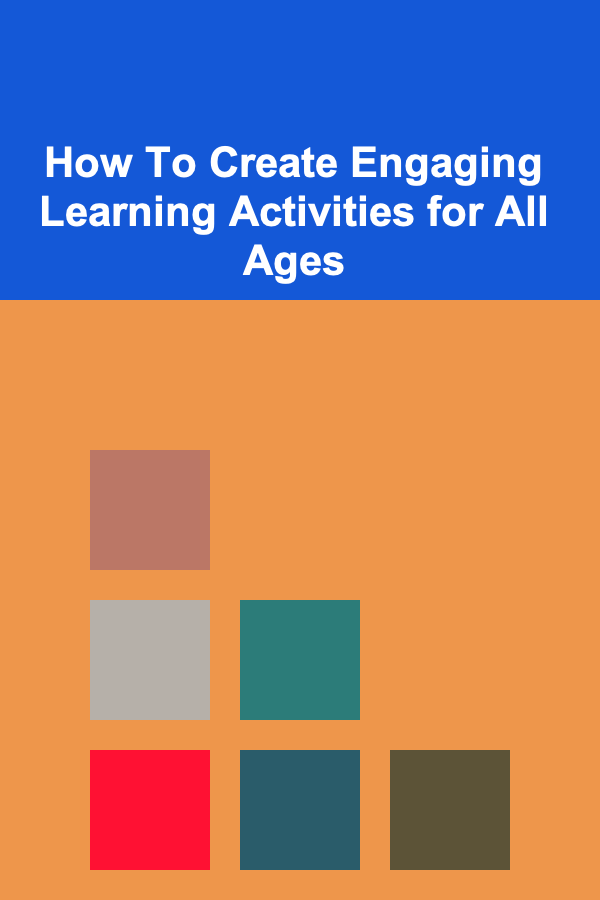
How To Create Engaging Learning Activities for All Ages
ebook include PDF & Audio bundle (Micro Guide)
$12.99$10.99
Limited Time Offer! Order within the next:

Learning is a lifelong process, and creating engaging learning activities is an essential part of making that process enjoyable and effective. Whether you're teaching children in a classroom or guiding adults in a workshop, the key to successful learning lies in how well the activity engages the participants. This article will explore the importance of creating engaging learning activities, offer practical strategies for all age groups, and examine how these activities can be adapted to cater to different learning needs and environments.
Understanding Engagement in Learning
Before diving into how to create engaging learning activities, it's important to first understand what "engagement" means in the context of education. Engagement in learning refers to the level of interest, curiosity, and motivation that learners exhibit when participating in an activity. Engaged learners are more likely to retain information, apply what they've learned, and feel empowered to continue learning.
Engagement goes beyond just fun activities. It involves actively involving the learner in the learning process, providing opportunities for exploration, discussion, problem-solving, and creativity. It encourages critical thinking, self-reflection, and the ability to apply knowledge in real-world situations. Engaging activities also cater to various learning styles, ensuring that all learners can connect with the content.
Why Engagement Matters
- Improved Retention: Engaged learners are more likely to retain information, as they are actively involved in the learning process.
- Motivation: When learners are engaged, they are more motivated to continue learning, even outside of formal educational settings.
- Critical Thinking: Engaging activities often encourage learners to think critically and explore different perspectives.
- Creativity: Engaging activities can help foster creativity, allowing learners to experiment and find new solutions to problems.
Now that we understand the importance of engagement, let's explore how we can design engaging learning activities for learners of all ages.
Creating Engaging Learning Activities for Children
When designing activities for young learners, it's essential to consider their developmental stages, interests, and attention spans. Activities for children should be interactive, hands-on, and designed to stimulate their imagination and curiosity.
1. Hands-On Exploration
Children learn best when they can explore concepts through touch, play, and experimentation. Hands-on activities provide an opportunity for them to engage with the material and understand it in a tangible way.
Examples:
- Building Blocks: Activities that involve building structures with blocks can teach children about geometry, balance, and spatial relationships.
- Science Experiments: Simple science experiments like making a volcano erupt with baking soda and vinegar can help children understand chemical reactions in a fun and memorable way.
2. Storytelling and Role-Playing
Storytelling and role-playing help children develop language skills, empathy, and creativity. By taking on different roles or creating their own stories, children can explore various perspectives and practice problem-solving in a safe and imaginative space.
Examples:
- Role-Playing: Children can act out different scenarios, such as being a doctor, teacher, or animal. This helps them learn social roles and develop communication skills.
- Interactive Storybooks: Using storybooks where children can make decisions and choose the direction of the story helps them feel empowered and engaged.
3. Games and Challenges
Gamification is a powerful tool for engaging young learners. By turning learning into a game, you can motivate children to participate and achieve learning goals without feeling pressured.
Examples:
- Treasure Hunts: Create a scavenger hunt where children search for hidden items related to the lesson. This can be adapted for learning about history, nature, or math.
- Educational Board Games: Games like "Chutes and Ladders" or "Memory" can reinforce math skills, vocabulary, and other subjects.
4. Movement-Based Learning
Incorporating physical activity into learning is especially important for younger children, who may have shorter attention spans and high energy levels. Movement-based activities allow children to learn while staying active.
Examples:
- Learning Through Dance: Use dance or movement to help children remember facts. For example, they can dance to a song about the alphabet or numbers.
- Active Learning Stations: Set up learning stations around the room where children move to different activities, such as jumping to answers or skipping to read new words.
Engaging Learning Activities for Teenagers
Teens are at a stage where they are developing more complex cognitive abilities, social awareness, and independence. To keep teenagers engaged, activities must be intellectually stimulating, socially interactive, and relevant to their interests and future goals.
1. Project-Based Learning
Project-based learning (PBL) allows students to work on real-world problems or create projects that have tangible outcomes. This type of learning fosters teamwork, critical thinking, and practical application of knowledge.
Examples:
- Group Research Projects: Assign students to research a topic and present their findings to the class. This encourages collaboration and helps students build presentation skills.
- Community Service Projects: Engage students in projects that address community needs, such as organizing a charity event or creating an awareness campaign about environmental issues.
2. Debates and Discussions
Teenagers are developing their ability to reason, form opinions, and engage in abstract thinking. Structured debates and discussions provide opportunities for them to voice their opinions, listen to different viewpoints, and learn how to argue constructively.
Examples:
- Debates on Current Events: Have students research and debate a current issue, such as climate change or technology's impact on society. This encourages critical thinking and research skills.
- Socratic Seminars: Organize open discussions where students explore a particular question or theme, allowing for deeper reflection and dialogue.
3. Interactive Digital Tools
Teenagers are often very comfortable with technology, so incorporating digital tools into learning activities can be a great way to engage them. These tools can also be used for collaboration, research, and content creation.
Examples:
- Online Quizzes and Polls: Use platforms like Kahoot or Quizizz to create interactive quizzes that challenge students and offer instant feedback.
- Creating Digital Content: Encourage students to create blogs, podcasts, or videos as part of their learning process. This taps into their creativity and helps them develop technical skills.
4. Hands-On Workshops
Teenagers benefit from hands-on activities that allow them to apply knowledge in a practical way. Workshops or skill-building sessions can give them the opportunity to develop both technical and soft skills.
Examples:
- Coding Workshops: Teach teenagers the basics of coding by having them build simple websites or apps. This skill is not only valuable for their future careers but also gives them a sense of accomplishment.
- Art and Design: Encourage teens to create their own artwork, graphic designs, or digital media projects. These activities help them develop creative and problem-solving skills.
Creating Engaging Activities for Adults
Adults engage in learning for various reasons, such as career advancement, personal enrichment, or practical life skills. To engage adult learners, activities must be meaningful, flexible, and applicable to real-world scenarios.
1. Real-World Problem Solving
Adults are often motivated to learn when they can see how the knowledge applies to real-world situations. Problem-based learning is an effective way to engage adults by having them solve real-life problems.
Examples:
- Case Studies: Present adults with case studies related to their field of interest and ask them to analyze the situation and propose solutions.
- Simulations: Create scenarios where adults must apply what they've learned to solve problems. For example, a business simulation where participants must make strategic decisions.
2. Collaborative Learning
Adults benefit from collaborative learning, where they can share experiences, insights, and knowledge with others. Group activities allow learners to build on each other's strengths and engage in meaningful discussions.
Examples:
- Group Workshops: Host workshops where adult learners work together on tasks, such as developing a business plan or creating a marketing strategy.
- Peer Reviews: Have participants review and provide feedback on each other's work. This encourages critical thinking and helps learners improve their skills.
3. Self-Directed Learning
Many adult learners prefer to take control of their learning process. Providing opportunities for self-directed learning allows adults to learn at their own pace and choose topics that interest them.
Examples:
- Online Courses: Offer online courses that allow learners to study at their own pace. These can be complemented with discussion forums and quizzes to promote engagement.
- Reading and Research Projects: Encourage learners to read articles or books on a particular subject and then share their insights with the group.
4. Interactive Workshops and Seminars
Adult learners often thrive in environments that encourage participation and interaction. Workshops and seminars that allow for hands-on activities, discussions, and Q&A sessions are highly effective.
Examples:
- Skill-Building Workshops: Offer workshops on topics such as public speaking, negotiation, or conflict resolution. These practical skills are often of high interest to adult learners.
- Guest Speakers and Panels: Invite experts in a field to speak to learners, followed by a Q&A session where participants can ask questions and engage in discussion.
Conclusion
Creating engaging learning activities for all ages is essential to fostering a love for learning and ensuring that educational experiences are meaningful. By designing activities that are hands-on, relevant, and interactive, you can inspire curiosity, critical thinking, and motivation in learners of any age. Whether you're teaching children, teenagers, or adults, the key is to understand the unique needs of your learners and provide opportunities that allow them to actively engage with the material. When learners are engaged, they are more likely to retain information, apply their knowledge, and continue to seek out learning opportunities throughout their lives.
Reading More From Our Other Websites
- [Organization Tip 101] What Are the Benefits of Using Baskets and Bins for Storage?
- [Personal Investment 101] Profiting from Deep Learning: A Guide to Monetization
- [Weaving Tip 101] Step-by-Step Guide: Creating a Boho-Chic Macramé Pillow Cover with Woven Accents
- [Beachcombing Tip 101] Sharing the Shore: How to Enjoy Beachcombing Without Disrupting Others
- [Home Budget 101] How to Make Small Changes in Your Home to Save Big on Monthly Expenses
- [Personal Financial Planning 101] How to Build a Strong Credit Score for Financial Security
- [Paragliding Tip 101] Maximizing Your Glide Ratio: Advanced Wing Tuning Techniques for Paragliders
- [Home Party Planning 101] How to DIY Centerpieces That Double as Decor and Conversation Starters
- [Home Cleaning 101] How to Clean a Kitchen: Tips for a Hygienic and Well-Maintained Space
- [Organization Tip 101] Affordable Options for Installing a Farmhouse Sink in Your Kitchen

How to Plan a Cozy and Chic Winter Party at Home
Read More
How to Use Folding Tables for Temporary Tool Storage
Read More
How to Use Smart Shelving to Save Space in Any Room
Read More
Prioritizing Goals Over Tasks: A Deep Dive
Read More
How to Age Wine in Oak Barrels
Read More
10 Tips for Improving Your Call Handling Skills as a CSR
Read MoreOther Products

How to Plan a Cozy and Chic Winter Party at Home
Read More
How to Use Folding Tables for Temporary Tool Storage
Read More
How to Use Smart Shelving to Save Space in Any Room
Read More
Prioritizing Goals Over Tasks: A Deep Dive
Read More
How to Age Wine in Oak Barrels
Read More